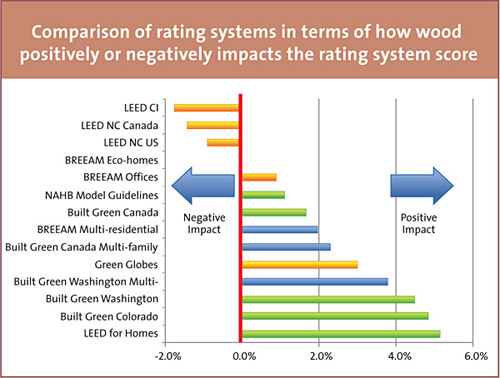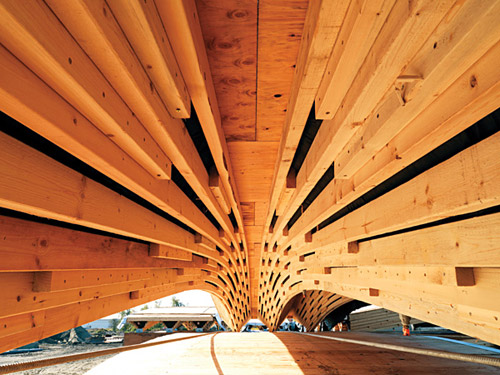Wood Rates: How Wood Products Stack Up in Green Building Systems
How Wood Impacts Rating System Scores
To understand the extent to which the use of wood aids or hinders rating system success, the study compared two theoretical projects in which the intensity of wood use was changed but all other considerations were held constant. In one "high intensity wood" project, wood is specified wherever possible. In the other "low intensity wood" project, other products are used in lieu of wood - selected based on their ability to maximize rating system point success. Several caveats applied. The assumption was that all wood-related credits would be achieved, regardless of cost or complexity - a scenario that is virtually impossible in reality. Some certified products are more difficult to specify than others, such as certified heavy timbers; some strategies are technically difficult or prohibitively costly to achieve; and some are challenged with regulatory constraints, including the use of wood in non-combustible construction. In addition, some systems could not be compared due to the integrated nature of the rating system and the structure and scope of the materials credits, as in Green Star and Living Building Challenge.
 |
|
Source: Light House Sustainable Building Centre |
Caveats notwithstanding, the analysis found that while the intensity of wood used in a project did not have a large impact on the number of total credits that can be achieved, it was clear that certain rating systems are more "wood-friendly" than others. Rating systems for single family homes such as Built Green were most predisposed towards wood, while commercial building systems such as LEED (U.S. and Canada) made it slightly easier to score points by not using wood. "Rating systems have become the definition of energy efficient and environmentally responsible building, and that represents a limited view," says Helen Goodland, Executive Director of the Light House Sustainable Building Centre. "Yet rating systems are continually evolving. How wood is considered is surely an area of interest to be explored."
Wood's Unrecognized Assets
"Wood can help designers create greener buildings, yet we found that wood's most significant ecological benefits - that it is the only carbon neutral construction material and that it can significantly reduce a building's life cycle impacts - are largely unrecognized by the most commonly used rating systems," says Goodland. She notes that there are gaps in most rating systems in areas where wood may play a positive role, including acoustical performance, life cycle analysis and material efficiency.
Yet even the attributes that go under-recognized by the rating systems, are not entirely ignored by architects themselves. Case in point is the Richmond Olympic Oval, home to long-track speed skating during the 2010 Olympic and Paralympics Winter Games, which achieved LEED Silver and Green Globes certifications.
The Oval features a roof structure built almost entirely from wood, both glulam beam arches and an unprecedented prefabricated system of "wood-wave" structural panels. This roof, which is one of the longest wood clear spans in the world, includes a roof deck consisting of one million board feet of conventional lumber linked together in undulating sections to create a coffered visual effect. Designed by structural engineers Fast + Epp and constructed at the design-build firm StructureCraft Builders Inc. in Delta, British Columbia, the roof evolved from what has been described as a "kitchen table idea," to a sophisticated design that was calibrated by complex computer models to test the load-bearing properties, subsequently modified and real life prototypes built.
Two roof options were developed during design. The roof size and shape of each option was virtually identical. The first option was constructing the roof from conventional steel trusses and acoustic steel deck. This was the "default" option. The second option was the "wood-wave" roof system which is a custom roof assembly consisting primarily of standard lumber with integrated building systems. The wood-steel arches are triangular-shaped and hide mechanical, electrical and plumbing equipment. Some 452 prefabricated wood wave panels span across the 15 enormous glulam arches. They are built of ordinary softwood 2x4s fastened together in a wave-like form. The designers distributed the pattern of the deck lumber to allow for structural mass reduction, aesthetic interest and acoustic absorption through the interior attenuation blankets.
 |
Richmond Olympic Oval received LEED Silver and Green Globes certifications. Photo: www.naturallywood.com |
As in any large space, acoustical performance was very important. "The acoustic performance criteria were established in relation to the acoustic performance of the perforated acoustic steel deck. The 'wood wave' had to demonstrate acoustical performance at least as good as this 'default' option,'" says Robert J. Johnston, AIA, Principal National Sport Practice Leader, Cannon Design Architecture Inc. in Victoria, British Columbia. "This was demonstrated to be the case. The acoustic separation properties were at 1.85 (to steel deck at 1.00) and the attenuation performance was at 1.15 (to steel deck at 1.00)."
While acoustics is an important part of any building seeking higher standards in indoor environmental quality, most rating systems ignore acoustical performance completely. In fact, of the systems surveyed in the Light House study, only Green Globes refers specifically to acoustical performance. Goodland calls that unfortunate, citing the fact that early post occupancy studies of green buildings show that acoustical performance tends to be below expectations. "Wood panel products and products containing wood fiber are particularly useful in sound abatement and control strategies," she says.









